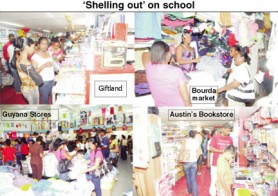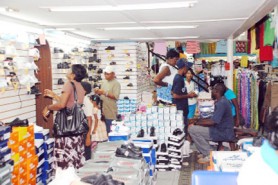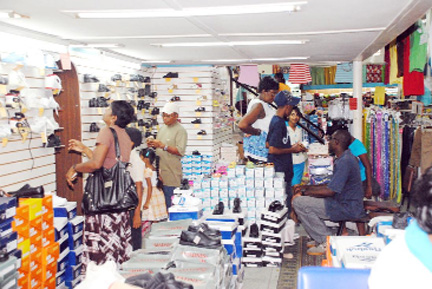Substandard shoes a major issue with parents
A steady stream of seasonal school supplies shopping which retailers say has persisted throughout the July/August holiday period will enter its final phase this weekend as parents prepare for their children’s return to school in just over a week. Beginning last weekend there was already evidence of the start of the customary last-minute rush though some of the city’s business houses trading in school supplies say that the next two weekends will see an even bigger increase in consumer spending on children’s school requirements.
 Stabroek Business has been monitoring back-to-school buying over the past two weeks and by last weekend the focus of consumer spending appeared to have shifted decisively in the direction of school supplies. While earlier this month parents could be seen ‘pricing’ both fabric and ready-made uniforms at stalls in the municipal markets and department stores, by last Friday shopping appeared to have begun in earnest. Cost and convenience considerations meant that most parents were favouring the ready-made uniform option. The bigger Georgetown department stores have, for some time now, been responding to shifts in market preference and the evidence in stores of ready-done boys and girls uniforms, apparently for every conceivable school suggest that some tailors and seamstresses have had a financially rewarding period producing a bewildering array of uniform options to meet the needs of off the peg consumers.
Stabroek Business has been monitoring back-to-school buying over the past two weeks and by last weekend the focus of consumer spending appeared to have shifted decisively in the direction of school supplies. While earlier this month parents could be seen ‘pricing’ both fabric and ready-made uniforms at stalls in the municipal markets and department stores, by last Friday shopping appeared to have begun in earnest. Cost and convenience considerations meant that most parents were favouring the ready-made uniform option. The bigger Georgetown department stores have, for some time now, been responding to shifts in market preference and the evidence in stores of ready-done boys and girls uniforms, apparently for every conceivable school suggest that some tailors and seamstresses have had a financially rewarding period producing a bewildering array of uniform options to meet the needs of off the peg consumers.
If those parents with whom Stabroek Business spoke were prepared to concede that the $1,500 state-issued uniform voucher had made a difference they were quick to point that the difference had been marginal. At some downtown stores a single ready-made uniform dress is being sold for around $1,300 while shirts and trousers could be acquired at around $700 each. Still, that appears to be the cheaper option. Most uniform fabric is being offered at around $450 per yard while checks with commercial seamstresses revealed that tailoring was costing up to around $1,300 per uniform.
Durability
By last weekend the shoe stores too had begun to provide evidence of the start of the customary last lap. Back-to-school shoe shopping, one Regent Street store owner told Stabroek Business, is less brisk business then it might appear. Since children must be brought along to enable accurate fitting the number of occupants of stores invariably far exceed the number of actual customers. Additional security and sales assistants push overheads up temporarily and, all too frequently, what ensues in the process of enquiry and fitting is no more than a weighing of options. Enquiries, frequently, do not convert into sales.
This year, the durability of shoes imported specifically school wear has been a major issue with parents. Some parents with whom Stabroek Business spoke were reporting “bad experiences” with last year’s shoe acquisitions with one parent reporting that between September 2009 and the July 2010 end of the school year, her 11 year-old son had gone through three pairs of shoes. The cheaper, commonly designated school shoes, she says, separate, top from bottom since they are pasted rather than stitched. The store owners were readily conceding the manufacturing flaw, recommending that the newly acquired shoes be reinforced through stitching. That, the mother pointed out was an “unfair” additional cost.

Some parents shopping for school shoes last weekend were also pointing to an increase in costs, in some cases, price hikes of up to $500 per pair. Inside a popular Regent Street shoe store last Saturday shoppers could be seen twisting and tugging their intended shoe acquisitions, apparently trying to make, at least, an inexpert determination regarding their durability.
Outside the Regent Street stores, the pavements have become hopelessly encumbered by vendors. The larger encumbrances are huge mountains of shoes and benches pressed into service as makeshift fitting areas. Chastened, it seems, by their experiences with conventional shoes, shoppers who had opted for making their purchases on the pavement appeared to be opting mostly for sneaker-type acquisitions. The prices, in most instances, were marginally higher, around $3000 but consumers now appear to have learnt the painful lessons of the cheap and sweet option.
Seasonal rivalry
Other pavement vendors, those offering ‘lesser’ items of school clothing – socks and underwear included – are engaged in the customary seasonal rivalry for sales. This year, it seems, new ‘alliances’ have sprung up between the vendors and the wave of Chinese merchants who have now become a fixture on the commercial landscape. Visits last week to China Trading on Robb Street, the single largest Chinese trading outlet in the city revealed that large numbers of downtown pavement vendors now appear to be favouring the cheaper Chinese school supplies – underclothing, socks, stationery, haversacks and lunch kits. Some Regent Street businesses have also quietly conceded that the cheaper Chinese offerings have made a dent in their own sales.
The issue of text book acquisitions has long been soured by the copyright issue and the huge illegal trade in copied text books that has blossomed in Guyana. As it happens, considerations of cost have meant that an overwhelming majority of consumers appear to have placed the moral and legal considerations behind them. Last Saturday, Stabroek Business spent more than half an hour inside Austin’s Bookstore which, avid readers insist, is the only ‘real’ bookstore in Georgetown. Visitors to the bookstore during that period numbered around a dozen persons. Most of them came, browsed and left. At another city shopping centre, probably the single largest commercial outlet for illegally copied texts in the city, the contrast was startling. Scores of children and parents were rivalling each other for the attention of shop assistants, waving book lists and examining the copied texts, altogether oblivious to their contribution to a worrisome legal and moral transgression. This newspaper’s own comparisons showed that prices for some basic texts revealed, in some instances, a differential of up to around 40 per cent and last weekend cash-strapped parents were putting their money where they could afford to. The few with whom we spoke after they had made their purchases appeared too relieved over the fact of their acquisitions to care.
Last weekend and earlier this week, Stabroek Business sought out the pavement vendors who have now joined the trade in copied books. Fewer of them were in evidence. By this weekend that might change. Unquestionably, unless something ‘gives,’ conventional bookselling could become thoroughly endangered.
The parents with whom we spoke, mostly wage earners, appeared eager to talk about the heavy seasonal financial burden associated with the start of the new school year. The sense we got was that some of them were awaiting receipt of their August salaries to start or complete their purchases. This year, like the previous year, overseas remittances which are customarily applied to back-to-school shopping have gone down.
Credit unions
Credit unions have long been playing a significant role in financing school purchases and this year was no different. Some of the smaller credit unions have been offering up to $50,000 in “school loans.” The larger ones have been offering more. One credit union official told Stabroek Business that up to 200 members had been provided with loans over a two-week period. “It is something that we have to prepare for every year. What we have discovered is that people prefer to apply to their credit unions rather than to resort to other sources that might sometimes involve higher rates of interest. Since the demand is so great we have to reduce the amount that we can lend to any one individual.”
Parents say that the free access to some text books from which children attending state schools benefit helps to alleviate the situation though, according to Ministry officials, government is beginning to count the cost of lost or damaged text books which the children ought to return to the schools at the end of the academic year. Government, for the time being at least, appears prepared to absorb the losses.
Inside Austin’s bookstore two pre-CXC students were cautiously examining texts for the science-based curriculum. They told us that there were no ‘fake’ copies of these particular texts available. Some books, it seems, are too cumbersome, too filled with complex diagrams, charts and statistics to be reprinted without damaging the detail. There is no way around acquiring these at the published prices. The two students, fifth form females were contemplating just this when we spoke with them inside Austin’s bookstore. One, just one of the texts was being offered at a price in excess of $6,000.

